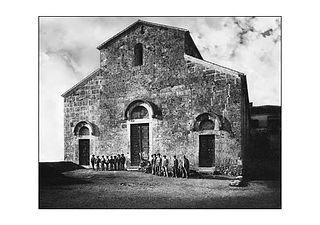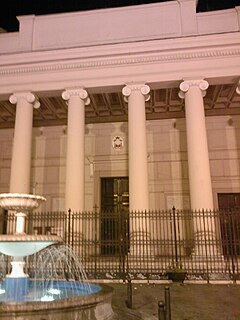
The Archdiocese of Genoa is a Latin Church ecclesiastical territory or diocese of the Catholic Church in Italy. Erected in the 3rd century, it was elevated to an archdiocese on 20 March 1133. The archdiocese of Genoa was, in 1986, united with the Diocese of Bobbio-San Colombano, forming the Archdiocese of Genoa-Bobbio; however a split in 1989 renamed it the "Archdiocese of Genoa."

The Roman Catholic Diocese of Ajaccio is a diocese of the Latin Rite of the Roman Catholic Church in France. The diocese comprises the whole of the island of Corsica.

The Roman Catholic diocese of Ferentino existed until 1986, when it was united into the new diocese of Frosinone-Veroli-Ferentino.
The Roman Catholic Suburbicarian Diocese of Velletri–Segni is one of the suburbicarian dioceses, Catholic dioceses in Italy close to Rome with a special status and a cardinal bishop, the bishop of Velletri–Segni. Historically, the see of Velletri was combined with the see of Ostia from 1060 to 1914.

The Italian Catholic Diocese of Savona-Noli in northern Italy, was historically the Diocese of Savona, from the tenth century. In 1820 the Diocese of Noli was united to the Diocese of Savona. It is a suffragan of the Archdiocese of Genoa.

The Diocese of Tivoli is a Latin Church ecclesiastical territory or diocese of the Catholic Church in Latium, Italy, which has existed since the 2nd century. In 2002 territory was added to it from the Territorial Abbey of Subiaco. The diocese is immediately exempt to the Holy See.
The Italian Catholic diocese of Fossombrone existed in the province of Pesaro and Urbino until 1986, when it was united into the diocese of Fano-Fossombrone-Cagli-Pergola. It was a suffragan of the archdiocese of Urbino.
The Italian Catholic diocese of Bertinoro existed from 1360 to 1986. In that year it was merged with the diocese of Forlì to create the diocese of Forlì-Bertinoro.

The Diocese of Acerra is a Roman Catholic ecclesiastical territory in Campania, southern Italy, eight miles east of Naples, in the area once called Terra Laboris (Liburia). It has existed since the 11th century. It is a suffragan of the Archdiocese of Naples.

The Diocese of Sessa Aurunca is a Roman Catholic ecclesiastical territory in southern Italy. Since 1979 it has been a suffragan of the Archdiocese of Naples.
The Italian Catholic diocese of Lacedonia, a suffragan of the archdiocese of Benevento in Campania, existed until 1986 when incorporated into the reorganized Roman Catholic Diocese of Ariano Irpino-Lacedonia.

The Diocese of Accia was a Roman Catholic bishopric on the island of Corsica. It is now a titular diocese. The diocese was located in the town of Accia in the interior region of Haute-Corse, which was destroyed and from which only some ruins remain. Established in 824 AD it was merged with the Diocese of Mariana in 1554. In 1570 the Bishop of Mariana and Accia moved his seat to Bastia.
The Diocese of Montemarano was a Roman Catholic diocese located in the town of Montemarano in the province of Avellino in the Campania region of southern Italy. It was erected in 1059, and was a member of the ecclesiastical province of Benevento. In 1818, the diocese was suppressed, and its territory and Catholic population was assigned to the Diocese of Nusco. The diocese of Nusco has been absorbed, since 30 September 1986, into the agglomerate Archdiocese of Sant'Angelo dei Lombardi-Conza-Nusco-Bisaccia.
The Diocese of Mariana in Corsica was a Roman Catholic ecclesiastical territory in Mariana, Corsica, in the north-eastern corner of the island. In 1563 the diocese was united with the Diocese of Acci(a) to form the Diocese of Accia and Mariana. Both dioceses were poor and had lost population. Mariana had been abandoned and its bishop lived in Bastia to the north, the seat of the civil government of the island. The Cathedral sat alone near the banks of the River Golo some three miles from the sea, in the midst of fields.
The Diocese of Aleria was a Roman Catholic diocese of the Latin rite, in the center of the eastern coast of the island of Corsica in the Department of Haute-Corse. The town of Aleria was subject to repeated raids by Arab fleets in the eighth and ninth centuries, and eventually abandoned, many of its people fleeing to the mainland. The bishop moved to a secure stronghold to the north. From at least the eleventh century, the diocese was a suffragan of the metropolitan archdiocese of Pisa. The diocese was suppressed by the Civil Constitution of the Clergy in 1790, and was not revived after the Concordat of 1801 between the French Consulate and the Papacy. It has been a titular diocese since 2002.
The Diocese of Venafro was a Roman Catholic diocese in Italy, located in Venafro, province of Isernia, region of Molise in the ecclesiastical province of Capua. On 1852 June 19, the diocese was suppressed and its territory and Catholic population transferred to the care of the Diocese of Isernia-Venafro.
The Diocese of Minori was a Roman Catholic diocese in Italy, located in Minori, province of Salerno, region of Campania in the ecclesiastical province of Amalfi. In 1815, it was suppressed, and its territory and Catholic population assigned to the Archdiocese of Amalfi.
The Diocese of Sagone was a Roman Catholic diocese in France, located in the city of Sagone, Corsica. In 1801, it was suppressed, and its Catholic population assigned to the Archdiocese of Ajaccio.

The Diocese of Nebbio was a Roman Catholic diocese located in the town of Saint-Florent in Corsica. The Cathedral is on a low hill one mile from the port of Saint-Florent. In the Medieval period the Bishop of Nebbio was also the temporal lord of nearly all the lands in his diocese. In 1667, Nebbio was completely abandoned and the bishop lived in Saint-Florent, a town of about 200 inhabitants, under the dominion of the Republic of Genoa. The diocese had some 22 places. The Cathedral Chapter had two dignities, the Archdeacon and the Provost, and three Canons. In 1770 the diocese was under the dominion of the King of France, and Saint-Fleur had about 600 inhabitants. The Chapter of the Cathedral still existed, with two dignities and six Canons.
The Diocese of Pienza was a Roman Catholic diocese located in the town of Pienza in the province of Siena, in the Val d'Orcia in Tuscany between the towns of Montepulciano and Montalcino. Until 1462, the town was known as Corsignano. It took the name Pienza from its most famous native son, Pope Pius II, who elevated the town to the status of a city (civitas), and established the new diocese. The diocese existed as an independent entity from 1462 to 1772, directly subject to the Holy See (Papacy).








